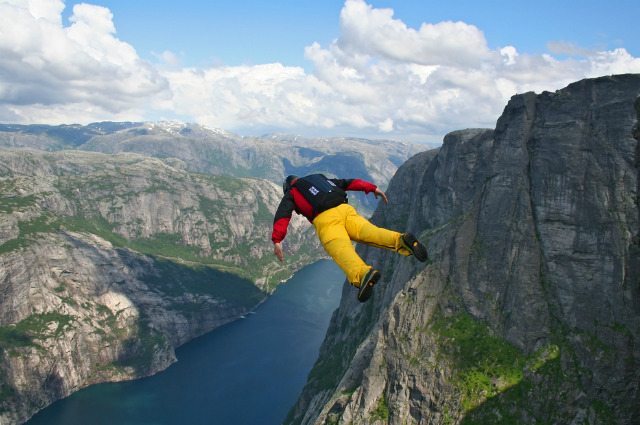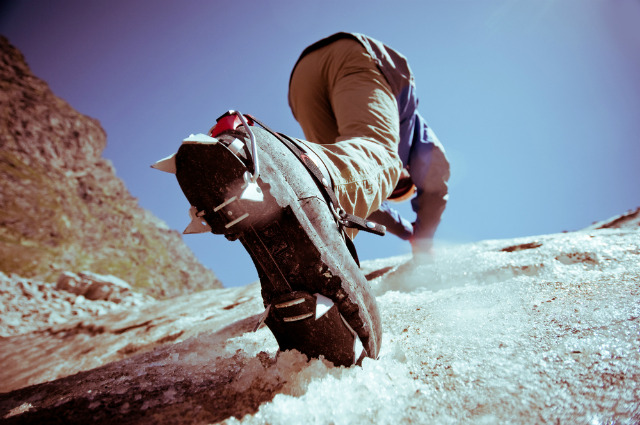13 Sports That Could Kill You
Speed skiing is the fastest non-motor sport on earth. (On land, anyway.) In this downhill discipline, which was demonstrated at the 1992 Olympics in Albertville, France, skiers try to hit the fastest speeds possible—often around 125 mph—on a straight, 1-km hill of hard-packed snow. The world-record holder and one of the sport's most dominant figures is the Italian Simone Origone (pictured), who hit 156 mph in 2006. Helmet aside, there's little, apart from skill, to keep Origone from sharing the deadly fate of several speed skiers past. And even without the element of speed, the hill itself can kill: In 2007 British women's champion Caitlin Tovar tumbled 3,000 feet to her death after losing her balance at the starting line.
Photo credit: Joydis Communications
Freediving
If you can hold your breath for minutes on end, freediving—that is, diving without supplemental oxygen—can give you an experience that scuba gear can't. Because freedivers don't breathe compressed air, they're less likely to scare off fish and they can go deeper and surface more quickly with less worry about decompression sickness; but the flip side of that equation is a high risk of blacking out too deep for rescue. Competitive freedivers have hit depths of over 700 feet using weights and nearly 400 feet without, but not without losing a few of their own along the way. In one well publicized case from 2002, French diver Audrey Mestre perished in a 561-foot descent under the supervision of her husband, fellow diver Francisco "Pipín" Ferreras, during a world-record attempt.
Big Wave Surfing
When you're dealing with waves of 20 feet or more, there's more than one way to bite the big one. Wiping out can mean being plunged deep underwater by the force of the crashing wave and being held there by subsequent waves—known as a multi-wave hold-down. Two of the sport's leading lights, Mark Foo and Sion Milosky, both drowned this way at Mavericks. If that wave happens to break over a shallow reef, like Tahiti's Teahupoo (pictured), falling can mean being smashed onto razor-sharp coral. At least five surfers have met their end there since 2000, according to The Australian.
BASE Jumping
It's all in the name. BASE jumping is the sport of plunging off of Buildings, Antennae, Spans (bridges) and Earth (cliffs) using only a parachute to keep you from hitting the ground at terminal velocity. But with only a few seconds (if that much) to pull the ripcord there's no room for error or equipment malfunction. Perhaps this is why the sport has the highest known death rate. Researchers from Stavanger University Hospital in Norway took a particular interest in the subject because nearby Kjerag Massif (pictured), towering 3,200 feet over a fjord, is one of the world's most popular BASE jumping sites. They found that nine out of 20,850 jumps— or 1 in every 2,317—between 1995 and 2005 were fatal, making BASE jumping five to eight times more deadly than parachuting out of a plane.
Free Solo Climbing
What could possess a rock climber to scale the 3000-foot vertical face of Yosemite's Sentinel without so much as a rope? "I still think free soloing is better style," says Alex Honnold (pictured), who made the world's jaw hit the floor when 60 Minutes aired footage of him doing just that. "It's just more pure." Few climbers are brave or skilled enough to attempt this sub-discipline of rock climbing, which forgoes safety equipment and climbing partners, and legendary free-solo pioneer John Long has an inkling why: "If you look at the past, people that have made a real habit of soloing, at least half of them are dead," he told 60 Minutes.
Big Water Kayaking
Whitewater kayaking is dangerous enough, but an elite few make a point of descending the world's biggest rapids, waterfalls and all. Take kayaker Tyler Bradt for example: Only 22 at the time, Bradt set the world record by successfully kayaking Washington's Palouse Falls in 2009—186 feet, or nearly 20 feet higher than Niagara Falls. But he didn't stop there. Bradt broke his spine in 2011 while attempting a 95-foot descent, and only a year later was part of a four-man team that conquered the Congo River's ferocious Inga Rapids (pictured), said to be the most dangerous on Earth. Whether he's able to keep it up is another matter: top kayakers meet their demise on class-5 rapids and waterfalls every year.
Wingsuit Flying
This sport gives new life to the expression "Man is not meant to fly." Typically done in conjunction with BASE jumping or skydiving, a flyer wears a suit the shape of a flying squirrel, shaving some 25 mph off his or her vertical velocity, but drastically increasing horizontal speed—in some cases over 200 miles per hour. While all but a few practitioners of this sport use parachutes, there's no guarantee that a flyer will get to use it. An errant gust of wind or a miscalculation can send you into the side of a cliff. And if your parachute does open, bad luck can cause you to shift direction unexpectedly, putting that cliff directly in your path—one of the most common causes of death, according to BASE jumping website BLiNC Magazine.
Downhill Mountain Biking
You don't have to be on skis to hurtle down a mountain at top speed. Downhill mountain biking has grown in popularity to the point that several of the top runs in the world are actually at off-season ski resorts—and, like skiing, the hazards are ever-present. In the competitive version of the sport, riders fly down rock- and root-laden trails, whip around switchbacks, drop over ledges and dodge tree branches to see who can get down the mountain the fastest. And although few riders have died in competition, the sport, overall, is dangerous. Many trails, like Moab's popular Porcupine Rim Trail, have sections of narrow singletrack alongside steep drop-offs. Here and elsewhere, more than a few downhillers have gone over the edge, which makes videos like this all the more impressive.
Freeride Snowboarding
Extreme snowboarders like Jeremy Jones have helped popularize a version of the sport called freeriding, in which boarders ride on natural terrain—an ungroomed mountain—rather than man-made obstacles, à la Shaun White. And although some of these runs look positively terrifying (witness Jones shredding Alaska's remote Wrangell-St. Elias Mountains in the film Further) the real danger, in most cases, is avalanches. Because freeriders call the backcountry home, they put themselves in prime avalanche territory, accounting for an increasing percentage of avalanche deaths in the U.S. and Europe. Just this year, five backcountry snowboarders were killed in an avalanche in Colorado.
Highlining
You may have seen your neighbor trying a safer version of this in his front yard between two trees. Slacklining is similar to tightrope walking, but uses a flat strip of nylon instead of a cable, and, of course, a more slack line that requires more balance than a tightrope. Invented by rock climbers, the most extreme version of this sport, highlining, has been embraced by daredevil free climbers like Dean Potter. While most highliners use safety harnesses (pictured) or BASE jumping parachutes, Potter has "free soloed" highlines in Yosemite and China's Enshi Grand Canyon, thousands of feet above the ground. That means no net, no harness, no nothing.
Parkour/Freerunning
It's no wonder this sport is a favorite among stuntmen. Parkour and its close variation freerunning are essentially the art of treating the world as an obstacle course. Practitioners attempt to run in a direction without breaking forward momentum, which more often than not means jumping, vaulting, flipping and rolling over barriers like railings and walls, and even leaping between buildings—all in as fluid a motion as possible. True, the likelihood of a freerunner's fatally smashing his or her head onto the pavement is proportional to the risks that runner takes, but as the sport grows in popularity, more people are taking those risks. Just last month, top Russian freerunner Pavel Kashin fell to his death after failing to land a backflip on a roof ledge.
Bicycle Road Racing
As anyone who has ever watched the Tour de France knows, those tight formations can be treacherous. One moment the peloton is descending a mountain in one unbroken group at 55 mph, the next, a rider spills on a curve, taking out the entire group like so many bowling pins and sending one head-first into a concrete barrier. In 1995 that rider was reigning Olympic gold medalist Fabio Casartelli, who died soon thereafter. Dozens of professional cyclists have died in competition over the years, and even more in training.
Mountaineering
Wherever there's a mountain people have tried to climb there's a list of people who have died climbing it. The most famous example, Everest, is littered with over 200 frozen bodies that are unrecoverable because of the extreme weather and altitude. Mountains have as many ways of defeating humans as humans have of summiting them: mountaineers die by rockslide and avalanche, falling into crevasses, slipping on ice, hypothermia, altitude sickness and equipment failure. And because so much depends on luck, experience is no guarantee of safety. In a study of 49 serious mountaineers in New Zealand, at least four had died while climbing by the time researchers followed up—only four years later.


